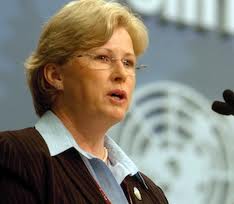We are in a global warming emergency. If we are a society that cares about leaving a safe climate for our children, and if Australia is to contribute fairly to the challenge of limiting global warming to two degrees, emissions from the electricity sector must ultimately fall to zero. Nuclear energy is too dangerous and too slow to build and carbon capture and storage is not ready and very unlikely to ever prove cost-competitive. A 100% reliance on renewable energy is therefore necessary and inevitable, it is just a question of when.
The cheapest way to decarbonise the electricity sector is to plan the transition early and build the right energy infrastructure in the right place at the right time. To avoid wasting time and money on investments that don’t adequately address climate change, we need a roadmap.
The Greens’ Clean Energy Roadmap has three goals:
– Power Australia with at least 90% renewable energy by 2030, by increasing the Renewable Energy Target (RET). This will give investors the certainty and stability they need to plan.
– Increase funding of the Clean Energy Finance Corporation (CEFC) to $30b by injecting $3 billion per year for ten years, to drive more change and private investment.
– Improve national electricity transmission planning to cost effectively exploit our huge renewable energy resources.
A goal of 100% renewable energy is achievable. The argument that renewable energy is ‘intermittent’ and therefore unreliable has always been a gross over-simplification peddled by those with a vested interest in slowing investment in renewable energy. Some types of renewable energy have variable output, such as solar PV and wind, but many others such as hydro, geothermal, biomass and solar thermal with storage can be dispatched reliably.
The draft report on achieving 100% renewable energy by the Australian Energy Market Operator (AEMO) shows that by using a range of renewable energy options Australia can maintain existing electricity supply reliability standards. Similar results have been published in the peer-reviewed journal Energy Policy by a research group at the University of NSW.
These reports also show it is affordable. Achieving 100% renewable energy by 2030 is projected to increase electricity prices by an amount similar to what will occur anyway if there is at least some global action on climate change. The draft AEMO 100% renewable energy study estimates potential increases in wholesale electricity prices, but unhelpfully does not forecast likely increases in electricity prices as a comparison. Other studies, however, have made such projections. There is a policy brief on my website which compares these studies in more detail.
Similarly, the UNSW study, which compared the cost of supplying the National Electricity Market with 100% renewable electricity with a ‘replacement’ scenario where fossil fuelled power stations are replaced with modern fossil fuel substitutes at projected 2030 costs, concluded:
At moderate carbon prices, which appear required to address climate change, 100% renewable electricity would be cheaper on an annual basis than the replacement scenario.
This study, like the AEMO study, simplified the analysis by assuming that all investment occurs in 2030. This understates the cost of the renewables scenario because by 2030 costs are projected to have fallen more than the cost of their fossil fuel alternative. On the other hand, the study uses Treasury projections for carbon prices to meet a 550ppm target, which is a lax target if the internationally agreed objective of constraining global warming to two degrees is to be achieved. More stringent targets, such as a concentration target of 450ppm, let alone 350ppm, would result in significantly higher global carbon prices and improve the relative competitiveness of renewable energy.
While the available analysis suggests achieving a 100% renewable energy target is both technically achievable and affordable, the Greens have a 90% RET for 2030 as a conservative stepping stone towards achieving 100%. A 90% target would be somewhat easier to achieve, especially if it reduced the need to build energy storage capacity to meet peak demand events.
A 90% renewable energy target for 2030 obviously justifies greater funding of the CEFC. The problem that it seeks to solve is that there are a range of financial barriers to commercialising and deploying cleaner energy technologies, including the historic public subsidies paid to fossil fuels. The guaranteed funding for the CEFC should be increased from $10 billion over five years to $30 billion over ten. This would increase spending from an average of $2 billion each year, to $3 billion each year for a decade. This greater level of funding is still small compared to the total level of investment required to achieve high levels of renewable energy.
The budgetary impact of the Greens’ plan to extend and increase the funding of the Clean Energy Finance Corporation will be based on the same accounting principles applied by the Treasury and the Department of Finance and Deregulation: If an entity in the general government sector is undertaking investments to achieve a return, then they do not impact on the budget bottom line.
Finally, to improve the coordination and planning of grid infrastructure, the Greens believe the AEMO should be established as a single, independent planning agency to administer a national transmission planning and reliability framework.
It will be much cheaper to anticipate a 100% renewable future and build appropriately sized grid infrastructure to support it, than to continue with incremental additions to generation and grid capacity. For example, some of the scenarios in the AEMO 100% renewable energy study project significant geothermal generation in the Cooper Basin. It would be an expensive mistake to build a low capacity transmission line to any new renewable energy zone if ultimately a high capacity line proved desirable to exploit the full potential.
Australia can’t yet rely primarily on carbon pricing to deliver an economically efficient level of renewable energy by 2030. Internationally agreed greenhouse gas mitigation policies and measures are not yet strong enough to achieve the goal of constraining global warming to two degrees. Unfortunately, there may be a delay before appropriately stringent emission targets are generating a suitably high carbon price signal. It is worth noting that many nations are still making greater progress with energy efficiency and renewable energy policies than they are with carbon pricing.
The fact that we still have tri-partisan support for a renewable energy target (although the Coalition will reduce the target) is in fact an implicit acknowledgement that the existing carbon pricing mechanism is in its formative stages and not yet driving the desirable level of investment in renewable energy.
The RET could therefore be considered as an insurance policy. While the rest of the world prevaricates about appropriate emission targets we can get on with the job of transitioning efficiently to renewable energy and all the innovation, investment and jobs that it generates before it’s too late.
Senator Christine Milne is leader of the Australian Greens










